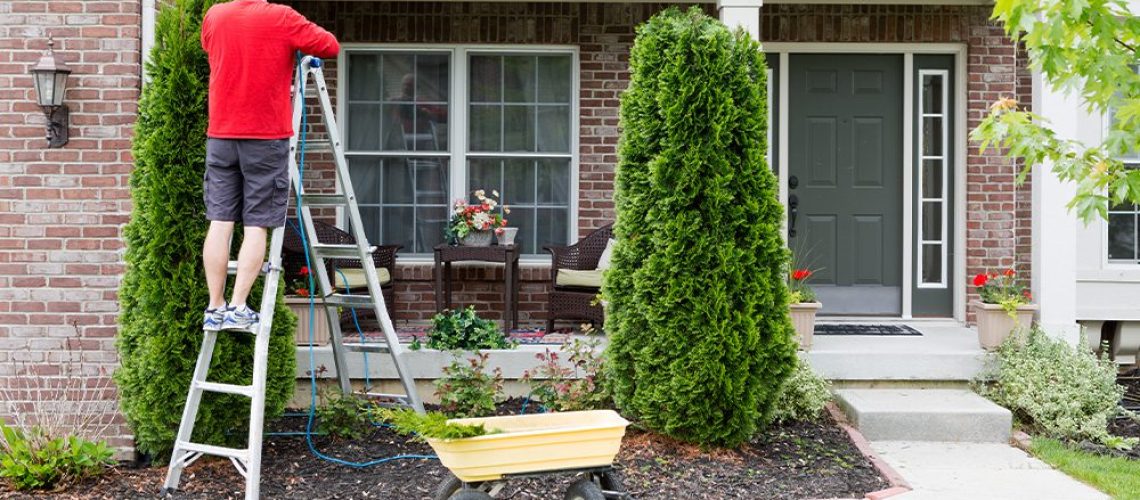- SHOP ONLINE
- AT THE GARDEN CENTRE
- BE INSPIRED
- LANDSCAPE SOLUTIONS
- EMPLOYMENT
- ABOUT US
Menu
- SHOP ONLINE
- AT THE GARDEN CENTRE
- BE INSPIRED
- LANDSCAPE SOLUTIONS
- EMPLOYMENT
- ABOUT US

During dark times, I always try to look for the light. I’ve said it before; I’m here, and you’re here, and that’s something to be grateful for. In fact, it seems like there’s more to be appreciated now than ever—like our health, our families, and our personal space.
Many, if not all of us, are spending more time at home than we’re used to, and that’s not such a bad thing. In fact, this is a prime opportunity to develop better habits to care for our homes and landscapes. For the foreseeable future, our dwellings are our sanctuaries, and taking this time to honour them feels good. For that matter, when so much seems to be out of our control, the things we can control are just that much more rewarding.
I doubt many of us typically wait with bated breath for spring pruning season, but maybe this year feels a little different. This year, let’s take a little more time with it. If you like, you can think about it as a sort of meditation—caring for the spaces that are now caring for us in return. Here’s how to get started.

Hand-held pruning shears are definitely the most important tool of the trade, but if you have larger landscaping plants to attend to, a pair of hedge shears is great for creating clean, flat lines while looping shears are great for nipping thicker branches. Whether you have just one or all three, keep them well-sharpened and disinfect them frequently with isopropyl alcohol or bleach.
If you have larger branches to handle, thicker than 2 cm in diameter, a pruning saw will come in handy. Make sure to enlist a housemate to help out if you’re cutting higher branches—they might be grateful for something new to do!
When pruning, cut at a 45˚ angle slanting away from the nearest bud. This diverts water away from buds and prevents rot. Cut just above branch nodes, which is the joint where new branches or buds develop.

Depending what plants are growing in your landscape, the pruning process will look a little different. Here are some tips for the most common landscape plant types in the Guelph area:
Deciduous trees: Prune as early as possible in the spring, before your trees leaf out, to promote fast recovery. Target branches that run the risk of slapping someone in the face, as well as any branches that cross or rub together. Thin out the canopies of any trees that have been in the ground for more than one year but less than five—now is a great time to cut back weaker growth and set them up for a strong, beautiful form.
Evergreens: Early spring is the perfect time to cut off any winter-burned branches or branch tips. Clean up dead material and gather fallen needles to use as an all-natural mulch—it’s great for keeping critters at bay. (Be careful to not prune too much, if you pass the green growth, there will be a hole for a very long time.)
Flowering shrubs: Immediately after their spring flowering period, prune forsythia, caragana, deutzia, flowering almond, lilac, and purpleleaf sandcherry. This is the perfect time to clean them up before they start setting new buds. Pay attention to low-growing branches that might cause tripping or unwanted wacks to passers-by.
Flowering vines: Prune hardy vines aggressively—they’re up to the challenge. Focus on thinning out overgrown areas to promote airflow through the vine.

Circumstances in Ontario are changing every day, but our commitment to you has not. Give us a call if any specific questions strike you, or if you’re unsure how to deal with a particular species. We wouldn’t be here without the support of our community, and we have every intention to return the favour as long as we’re able.
HOURS
JOIN US YEAR-ROUND!
Hours of Inspiration
Monday to Friday: 9am – 6pm
Saturday: 9am – 5pm
Sunday: 10am – 5pm
BE INSPIRED
Sign up for our E-Newsletter to receive garden tips, landscaping advice and more, delivered right to your inbox.
Sign up today!
Find Us